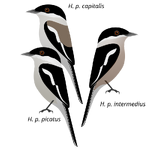| Tityridae | |
|---|---|
| File:Pachyramphus castaneus.jpg | |
| Chestnut-crowned Becard | |
| Scientific classification | |
| Kingdom: | Animalia |
| Phylum: | Chordata |
| Class: | Aves |
| Order: | Passeriformes |
| Suborder: | Tyranni |
| Family: | Tityridae G.R.Gray, 1840 |
| Genera | |
|
7, see text | |
Tityridae is family of suboscine passerine birds found in forest and woodland in the Neotropics. The approximately 30 species in this family were formerly spread over the families Tyrannidae, Pipridae and Cotingidae (see Taxonomy). As yet, no widely accepted common name exists for the family, although Tityras and allies and Tityras, Mourners and allies have been used. They are small to medium-sized birds. Under current classification, the family ranges in size from the Buff-throated Purpletuft, at 9.5 cm (3.75 in) and 10 grams (0.35 oz), to the Masked Tityra, at up to 22 cm (8.7 in) and 88 grams (3.1 oz).[1][2] Most have relatively short tails and large heads.
Taxonomy
Traditionally, the genus Laniocera was included in the family Tyrannidae, the genera Iodopleura, Laniisoma, Tityra, Pachyramphus and Xenopsaris were included in the family Cotingidae, and Schiffornis was included in the family Pipridae. Three of these genera, Tityra, Pachyramphus and Xenopsaris, were later moved to Tyrannidae based on the morphology of their skull and syrinx.[3]
The existence of the family Tityridae (although simply treated as a clade) was first proposed in 1989 based on the morphology of several syringeal and skeletal features.[4] The existence of this family has later been confirmed by multiple studies involving both mtDNA and nDNA.[5][6][7][8][9] Evidence suggests there are two basal clades within this family, the first including the genera Schiffornis, Laniocera, and Laniisoma (with strong bootstrap support), and the second include Iodopleura, Tityra, Xenopsaris, and Pachyramphus (with poor bootstrap support).[10]
Species
In addition to the species listed below, the Swallow-tailed Cotinga and Kinglet Calyptura may belong in this family, but hard scientific data is lacking, and they are therefore considered incertae sedis by recent authorities such as SACC.[11] Recent evidence suggests that the Sharpbill belong in this family,[5][6] but, as recommended by SACC, it is retained as incertae sedis until this placement is confirmed by additional data.
- genus Tityra.
- Black-crowned Tityra (Tityra inquisitor).
- Black-tailed Tityra (Tityra cayana).
- Masked Tityra (Tityra semifasciata).
- genus Schiffornis.
- Varzea Schiffornis (Schiffornis major); alternatively Várzea Mourner.
- Thrush-like Schiffornis (Schiffornis turdina); alternatively Thrush-like Mourner - probably includes several species-level taxa.[12]
- Greenish Schiffornis (Schiffornis virescens); alternatively Greenish Mourner.
- genus Laniocera.
- Speckled Mourner (Laniocera rufescens).
- Cinereous Mourner (Laniocera hypopyrra).
- genus Iodopleura.
- White-browed Purpletuft (Iodopleura isabellae).
- Dusky Purpletuft (Iodopleura fusca).
- Buff-throated Purpletuft (Iodopleura pipra).
- genus Laniisoma.
- Shrike-like Laniisoma (Laniisoma elegans).
- Brazilian Laniisoma (Laniisoma (elegans) elegans).
- Andean Laniisoma (Laniisoma (elegans) buckleyi).
- Shrike-like Laniisoma (Laniisoma elegans).
- genus Xenopsaris; possibly better merged with Pachyramphus.
- White-naped Xenopsaris (Xenopsaris albinucha) .
- genus Pachyramphus.
- Green-backed Becard (Pachyramphus viridis).
- Yellow-cheeked Becard (Pachyramphus (viridis) xanthogenys).
- Barred Becard (Pachyramphus versicolor).
- Slaty Becard (Pachyramphus spodiurus).
- Cinereous Becard (Pachyramphus rufus).
- Cinnamon Becard (Pachyramphus cinnamomeus)
- Chestnut-crowned Becard (Pachyramphus castaneus).
- White-winged Becard (Pachyramphus polychopterus).
- Black-and-white Becard (Pachyramphus albogriseus).
- Grey-collared Becard (Pachyramphus major).
- Black-capped Becard (Pachyramphus marginatus).
- Glossy-backed Becard (Pachyramphus surinamus).
- Rose-throated Becard (Pachyramphus aglaiae).
- Jamaican Becard (Pachyramphus niger).
- One-colored Becard (Pachyramphus homochrous).
- Pink-throated Becard (Pachyramphus minor).
- Crested Becard (Pachyramphus validus).
- Green-backed Becard (Pachyramphus viridis).
References
- ^ http://www.arkive.org/buff-throated-purpletuft/iodopleura-pipra/
- ^ http://books.google.com/books?id=40mFwoALUFUC&pg=PA648&lpg=PA648&dq=masked+tityra+cm&source=bl&ots=1QWw-97zQ0&sig=DOY8lyPDa8N0soy41DWzG53PUiM&hl=en&ei=uGyCTdb9FoKztwed4q22BA&sa=X&oi=book_result&ct=result&resnum=3&ved=0CBwQ6AEwAg#v=onepage&q=masked%20tityra%20cm&f=false
- ^ Ames, P. L. 1971. The morphology of the syrinx in passerine birds. Peabody Museum of Natural History Bulletin, v. 37.
- ^ Prum, R. O., & W. E. Lanyon. 1989. Monophyly and phylogeny of the Schiffornis group (Tyrannoidea). Condor 91: 444-461.
- ^ a b Ericson, P. G. P., D. Zuccon, U. S. Johansson, H. Alvarenga, and R. O. Prum. 2006. Higher-level phylogeny and morphological evolution of tyrant flycatchers, cotingas, manakins, and their allies (Aves: Tyrannida). Molecular Phylogenetics and Evolution 40:471-483.
- ^ a b Ohlson, J. I., R. O. Prum, and P. G. P. Ericson. 2007. A molecular phylogeny of the cotingas (Aves: Cotingidae). Molecular Phylogenetics and Evolution 42:25-37.
- ^ Chesser, R. T. 2004. Molecular systematics of New World suboscine birds. Molecular Phylogenetics and Evolution 32: 11-24.
- ^ Johansson, U. S., M. Irestedt, T. J. Parsons, & P. G. P. Ericson. 2002. Basal phylogeny of the Tyrannoidea based on comparisons of cytochrome b and exons of nuclear c-myc and RAG-1 genes. Auk 119: 984-995.
- ^ Prum, R. O., N. H. Rice, J. A. Mobley, and W. W. Dimmick. 2000. A preliminary phylogenetic hypothesis for the cotingas (Cotingidae) based on mitochondrial DNA. Auk 117: 236-241.
- ^ Barber, B., & N. Rice. 2007. Systematics and evolution in the Tityrinae (Passeriformes: Tyrannoidea). Auk 124(4): 1317-1329.
- ^ Remsen, J. V., Jr., C. D. Cadena, A. Jaramillo, M. Nores, J. F. Pacheco, M. B. Robbins, T. S. Schulenberg, F. G. Stiles, D. F. Stotz, & K. J. Zimmer. 2007. A classification of the bird species of South America. American Ornithologists' Union. Accessed 12 December 2007.
- ^ Nyári, Á. S. 2007. Phylogeographic patterns, molecular and vocal differentiation, and species limits in Schiffornis turdina (Aves). Molecular Phylogenetics and Evolution 44: 154–164
| Wikimedia Commons has media related to: http://commons.wikimedia.org/wiki/Category:Tityridae |

|
This article is part of Project Bird Families, a All Birds project that aims to write comprehensive articles on each bird family, including made-up families. |

|
This article is part of Project Bird Taxonomy, a All Birds project that aims to write comprehensive articles on every order, family and other taxonomic rank related to birds. |
| This page uses Creative Commons Licensed content from Wikipedia (view authors). Please help by writing it in the style of All Birds Wiki! |
